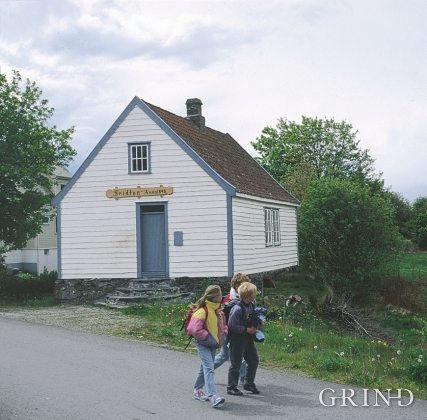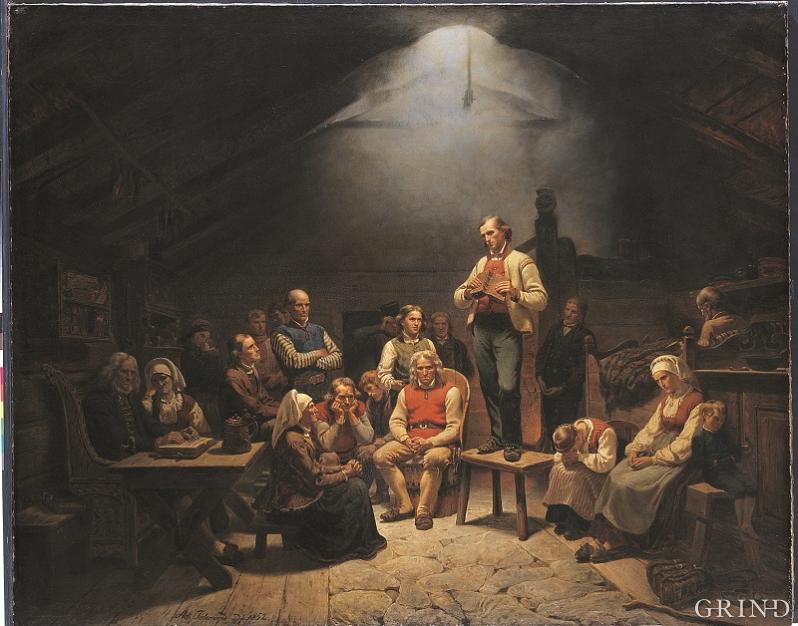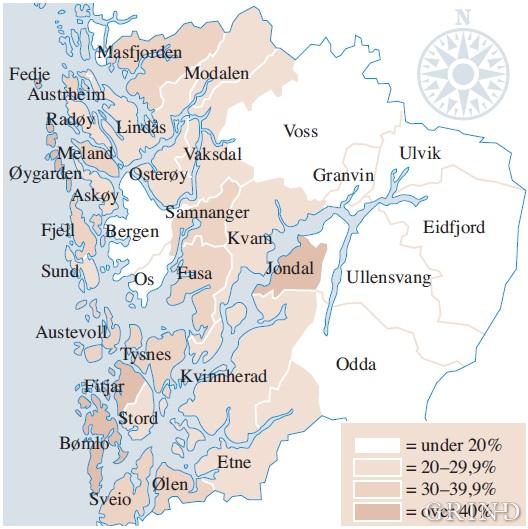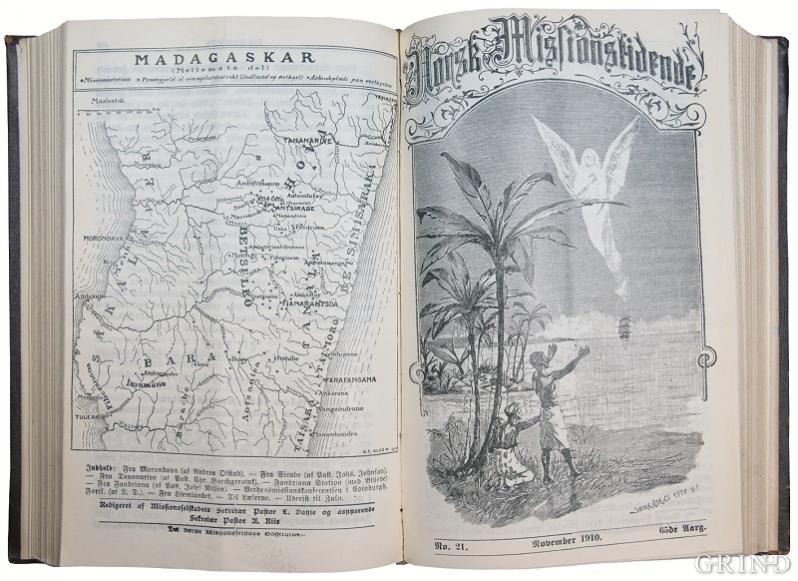Published: 19.05.2009 | Author: Karl Egil Johansen
“We have raised a house in God’s honour;Jesus came with consecration and peace,So for our community let there be God’s word in this holy place” Fridtun” chapel at Hillestveit in Bømlo, built in 1845 was one of the early chapels in the country, and the first in Finnås Parish. It has now been restored and put into good order as a museum. (Ronny B. Skaar).
If you see a particularly ugly building out in the country, a bit bigger than what houses normally are, with large cold windows, it is obviously a chapel, if it is not a youth house or a school house”. It was the architect Johan Lindstrøm who came with this attack on the architecture of the chapel in an article on “Official buildings in the rural areas” from 1927. We regard this characterisation today as more of a caricature with a sting against the “un-Norwegian” Swiss style which influenced many of these buildings from the turn of the century. But more than the style and the architectural expression, it is the cultural and ideological aspects which capture our interest. Cultural radicalism’s one-sided picture of the chapel as an exponent for puritanical narrow-mindedness and opposition to culture has been replaced today by a wider and more nuanced view of an important cultural factor in Norwegian society. The chapel, a meeting place for the Christian layman’s movement is the bearer of a democratic Low Church tradition with strong social engagement and an attitude towards resources and values which speak to our own times: “Fear of God and frugality is the great gain”
The chapel and the Christian layman’s movement have not enjoyed a powerful position in all of western Norway. There seems to be a division between the outer and the inner rural districts, not least in Hordaland County. Even although it is not quite true, what was said in an old anecdote that there are neither chapels nor adders in Hardanger, at least they are very few. It is true that Ulvik got its first chapel in 1889 and Odda and Ullensvang twenty years later. But then that was the end of it, and after a survey about 1960 it was found that neither Granvin, Eidfjord or old Kinsarvik municipality had a chapel. The laymen’s movement had much more productive soil in the outer coastal rural districts and the densest distribution of chapels is in Fjell and Bømlo. More than 20 chapels have been built in both of these municipalities.
In a political context the number of votes cast for the Christian People’s Party may be used as a measure on how the strength of the layman’s movement has varied. The Christian People’s Party was founded before the Parliamentary elections in 1933, in the first instance as a purely Hordaland party. For a long time it was difficult to find anyone on the electoral lists who were not active chapel folk. Most of them were attached to the Western Norway Home Mission Association and the Norwegian Lutheran Association, the two biggest layman organisations in the county, and the most radical - radical in the meaning of being independent of the State Church.
Other parties have also provided places to typical representatives of the layman’s movement, especially the Party of the Left. During the first years after the second World War, it was Haldor Haldorsen, owner of Wichmann engine factory in Rubbestadneset and Pdder Nilsen Aga, the characteristic mayor of Fitjar who were central figures. Both of these were left-wingers. Haldorsen served for two sessions as a member of Parliament. However after the Christian People’s Party was established there is no doubt who appealed most to those who attended the chapel. Yes, much of the background for the establishment of the Christian People’s Party was precisely the discontent with the place the chapel folk had been given on the established parties’ list of candidates.
In those rural areas where the layman’s movement was weakest, another important movement was important and that was the Liberal Movement. Through the many young folks’ clubs, dialect societies, shooting clubs, song and music clubs, Voss and Inner Hardanger areas became core areas for that movement at any early stage. It is worth noting that municipalities like Fana, Haus and Os close to Bergen city were also involved in the movement. On the coast, on the other hand, the Liberal Movement made little headway. Of over 60 youth houses in Nordhordland and Midthordland around 1910 there were only 4 which belonged to the typical coastal municipalities. If we view the Liberal Movement and the puritanical Layman’s Movement as ideological opposites, the youth house and the chapel could easily become “fortresses” for the two different cultures, if not in armed conflict then at least in a “cold war” with each other.
In some rural areas it was certainly like this. Even although most of those in the liberal movement did not say “No” to Christianity and the Christian way of life, they saw little positive in what went on in the chapel. From the layman’s movement’s point of view it was dancing which made the main dividing line. It was usual for a lot of alcohol to be consumed in conjunction with dance arrangements. Many of the leaders of the liberal movement admitted that this was a problem, and put a lot of effort into trying to change old drinking traditions. Jens Tvedt has written novels which portray the conflict between the liberals and the chapel folk in Kvinnherad, and the layman’s movement in this municipality has been analysed by historians (Døssland, 1975).
But Kvinnherad is not typical. Much indicates that this municipality, with six chapels and six young folks’ clubs was one of the most divided and most “polarised” here in Hordaland County. We find something of the same in other rural areas along the fjords, for example at Osterøy and in Kvam. But out on the coast where the layman’s movement was strongest, and in the inland districts where the liberal movement had hegemony, there was less reason for such conflicts. A characteristic dilemma illustrates this: whilst the chapel management committee in Kvinnherad was very restrictive in hiring out the chapels to other folk, the liberal movement youth in Fedje were allowed to borrow the chapel for their New Year party; of course without dancing, but even so, pretty unthinkable in Kvinnherad.
In other words the relationship between the liberal movement and the layman’s movement has not been uniformly negative. Criticism and antagonism have at times been replaced by peaceful co-existence. In some cases there have even been surprising examples of cooperation, amongst others in the work for the New Norwegian language. The language issue experienced a set-back for a long period in the areas of the Christian layman’s movement. What brought about a change was the fact that several of the best-liked lay preachers took to using the New Norwegian language. LUDVIK HOPE from Masfjorden and Mathias Orheim from Nordfjord played a very important role in making way for the New Norwegian language amongst chapel folk. In 1907 Orheim moved to Nesttun near Bergen, when he was called up as a travelling lay preacher for the Western Norwegian Home Mission Society.
Mathias Orheim travelled for over fifty years as a travelling lay preacher, but he left behind him an even more lasting memorial as a writer of psalms. In his youth he had been a member of the liberal movement’s youth wing, until, no more than sixteen years old, he experienced a personal conversion at a meeting where Ludvik Hope himself was the main speaker. Orheim was captivated by both the content and the form; that Hope spoke in a language which had been described as the language of a freethinker. When he himself began to travel round on singing and speaking engagements, Orheim always used the New Norwegian language. In fact in 1916 the West Norwegian office for the New Norwegian language in Bergen asked him to do a speaking tour on behalf of the New Norwegian language. In Hordaland County the effort was to be concentrated in those areas where the New Norwegian language was weakest, that is along the coast, and Orheim was allowed to speak about anything he wanted. The only condition was that people should hear “Norwegian spoken about uplifting themes” as it was said. Orheim said yes, and arranged a trip where part of it was preaching meetings for the Home Mission, and part of it was talks on the language. From Fjell he reported to the New Norwegian Language office that he had come across: “the most fanatical opposition to the work with the New Norwegian language, that I have encountered on the whole trip”.
The New Norwegian language office which had difficulties in finding professional agitators for the New Norwegian language to travel round these districts which were antagonistic to the language, were well pleased with Orheim. The year after they engaged him once more and he travelled into 90 school districts in Nordhordland and Midthordland. The average attendance at such meetings was 200, so that there were quite a few thousand folk who heard the language lectures given by Orheim. This cooperation across the traditional dividing lines was otherwise not quite unique. In Fana in 1905 the newly founded New Norwegian language society joined up with the Home Mission to arrange meetings where the lay preachers were to speak New Norwegian and only psalms by Blix were to be sung. If we go even a little further back, we can find that the first Chairman of the Bergen Home Mission, Olav Paulsen was an ardent proponent of the New Norwegian language. Amongst other things Paulsen was involved in establishing the West Norway Association (1868). He was elected to the board of directors and served as treasurer for a number of years. Paulsen published a reader in New Norwegian, apparently the first of its kind.
In a somewhat wider perspective the layman’s movement and the liberal movement, despite differences and ideological divides, have had clear similarities. Both of them are an expression of the strong growth in organisational life. Especially from the second half of the 19th century and through the years between the wars both organisations functioned as a social lever and a school for folk who would later in life take on major responsibilities in society. This was at the rural level, the county level and on the national level. The leading lights of the layman’s movement did not stand there cap in hand neither for the priests nor for the civil servants. Lay people should be “authoritative laymen” and through the meetings in the chapel, there were many who received training in standing up in front of an audience and making speeches. It was the same for young folks’ societies and other liberal work. This educational or public information side was supplemented and strengthened by the schools produced by these movements: the local colleges - those inspired by Grundtvig - as well as the Christian ones.
“Freedom, Norwegian-ness, Christianity” was the motto for the liberal schools. Right up to our own times, many a mayor in the county has managed with the higher education he or she received from a winter course at the local college.
In addition both movements have given expression to cultures counter to liberal values and attitudes from urban areas. Both in the chapel and the youth house they were aware of this at an early stage. Otherwise as it was said by a leading youth representative as early as the 1890s: “the real enemy of the liberal movement should not be Puritanism, but idleness and indifference amongst people who “existed in a rawer, more disgusting darkness than any puritan” . But not everyone had the same patience and tolerance, either then or later. For many people the layman’s movement and the chapel were synonymous with a darker view of life, censoriousness and worse than that too.
It is difficult to be objective here. A lot depends whether one is “on the inside” or “on the outside”. To put not too fine a point on it: The cultural radical from the capital city who has never set foot in a chapel can never understand the layman’s movement in the same way as those who know the chapel as their spiritual home. In addition it touches upon a particularly personal part of life where it is easy to create a division, for or against. This is truest of all as regards preaching. When the preacher, with God’s word, the language of Canaan, as it was usually called, uses expressions like “sin, conversion and saving, those on the outside will be repelled and will interpret it as fanaticism. Those on the inside, on the other hand will claim that preaching with such a content is healthy and the “true word”, “good, spiritual nourishment” to put it in the Biblical language. Something the same is true of ways of expression; not least the place given over by meetings in the chapel to weeping. For many people this can seem somewhat sentimental, and even contrived. For their part, however, the chapel folk, especially in the earlier days, seen such subjective expressions as a natural way of showing one’s feelings, both in sorrow and in joy.
In those rural districts where the layman’s movement was strongest, the chapel was involved in affecting the whole local society. In several places the chapel was the only larger assembly hall. It often functioned not only as a meeting place for the Overseas and Home Missions, but also as a village hall. Here they arranged both the Christmas festivities and the celebrations for Constitution Day (17th May) and here people came together for memorial services in connection with burials and here the local fishing society could hold its meetings. Even the County Council used the chapel. Thus in 1883 the County Council of Hordaland met in the new chapel in Norheimsund. And with this is associated a telling story. In the beginning of the 1880s the conflict between the radicals and the conservatives had become intense, not only in the national Parliament, but also in the County Council in Hordaland. When a proposal came up in the Council in 1882 to hold the next County Council meeting in Norheimsund, the representative from Kvam, Nils Skaar, the elder said that he was not sure if this would be possible. They did not have any other usable meeting place than the chapel and the owners had said that they would not permit political meetings. Now since the County Council dealt with such matters he did not know whether they would be allowed to use the chapel. Skaar must have been able to convince the chapel management committee. In any event the County Council was held in Norheimsund next year.
Otherwise the County Council was no major gathering compared with the gatherings that the layman’s movement was responsible for in this period. The annual meeting of the Sunnhordland, Hardanger and Voss Home Missions gathered together about 10,000 people; with the same number in Strandebarm three years previously. Probably there had never been bigger assemblies of people in this part of the country and neither the chapel nor the church were able to house such numbers. Lars Oftedal who was a speaker at the meeting in Strandebarm in 1880 described it in this way:
“We gathered together in a higher valley, called Grønnedalen, just above Brubøen. Willing hands in the district had assisted in getting the place arranged for the purpose where we could see in advance that the church could only accommodate a small proportion of those gathered there, which turned out to be about 10,000 people who filled the whole valley from the top to the bottom and up the sides too.”
When people came together in this way, it must have been to give them a view out over the village and the local community. This was even more so for the overseas missions. With prayers and the singing of psalms, readings from the mission’s magazine, knitting socks and holding bazaars, they created a vision and engagement for people thousands of kilometres away. Long before internationalism and modern ideas on one world were in fashion, Landstad’s great missionary psalm rang out from church and chapel with: “Welcome to all of you far and near to the Lord’s community of brothers and sisters here”. Long before a penny in development aid was sent out, the missionary organisations started up aid programmes for the needy in Africa and Asia. Hospitals were built and schools were opened. The money came from people who seldom belonged to the better-off classes in society. This strong, social engagement is one aspect of the chapel and the layman’s movement which has been undervalued, by their critics and in the image of themselves which the movement’s own historians drew up.
It could be well worth the effort to know the history hidden behind the window of the chapel. We can take the chance in saying that this seldom attracts the interest of those marketing western Norway for the tourists. But just as much has the chapel and the layman’s movement been an important cultural factor for Norway.
- Døssland, A. (1975) Den organiserte lekmannsrørsla i eit vestnorsk bygdesamfunn frå omkring 1890-1945: ei gransking frå Kvinnherad. Hovudoppgåve, Universitetet i Trondheim.
- Døssland, A. (1977) Organisert lekmannsrørsla i Kvinnherad ca. 1890-1945. I: Sunnhordland Årbok. Stord, Sunnhordland museum, s. 7-29.
- Eide, B. (1963) Med livets rett: Bergen Indremisjon gjennom 100 år. Bergen.
- Handeland, O. (1955) Ludvig Hope. Bergen, Lunde.
- Straume, J. (1952) Kristenliv i Bjørgvin: frå Selje til Sund. Bergen.
- Straume, J. (1960) Trubaduren: Mathias Orheim. Bergen.
- Aagedal, O. red. (1986) Bedehuset: rørsla, bygda, folket. Oslo.









